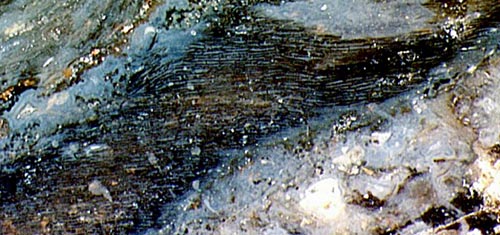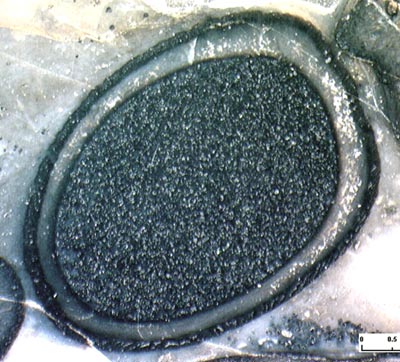Twisted evidence
The sporangia most easily recognized as such in the Rhynie chert are
those of Aglaophyton.
They are often split lengthwise (Fig.1), and
sometimes a twist in the texture of the wall
is distinctly seen. This led to
the assumption that the twist might have originated as a result of
splitting [1], as it is known from the seed pods of several leguminous
plants, where mechanical stress built up by drying of the ripe pod is
released in a sudden burst scattering the seeds and leaving the halves
of the empty pod in a twisted state.


Fig.1 (far left): Cross section of
empty Aglaophyton
sporangium split
lengthwise, sides overlapping, inner
wall layers absent owing to decay. Note also the level bands in the
cavity.
Fig.2: Side view of
non-split Aglaophyton
sporangium with
right-hand thread
texture. (The wall is cut off above.)
There is, however, ample evidence that the twist of
Aglaophyton
sporangia is not due to splitting but is an inherent feature. Fig.2
provides a view on the outside of a sporangium lying just below the cut
and polished face of the chert sample. Apparently the sporangium is not
split but the twist in the texture of the outer wall is clearly there.
(See also Rhynie
Chert News 62.) More evidence comes from inclined sections of non-split sporangia
(Fig.3): The sporangium wall cells appear wider on one side of the
capsule and narrower on the opposite side. This is what is expected
from elongated cells arranged nearly parallel to the axis of the
lengthy capsule except for a slight twist or spiral texture, since they
are more inclined with respect to the cut face on one side and less
inclined on the other one so that their width seems to vary
correspondingly along the circumference.* 
Fig.3: Inclined section of non-split
Aglaophyton
sporangium whose spiral texture can be inferred from the
apparent width of the outer wall cells changing along the
circumference. Photographs by
H. Sahm.
In [1], an epidermis texture is shown which seems to belong to a
sporangium with a left-handed twist, while ours in Fig. 2 is clearly
right-handed. This is suspicious since Nature often prefers one type of
thread, which suggests the idea that the picture in [1] had been
obtained with the peel technique which gives the mirror image of the
real thing and hence transforms right into left hand thread if one does
not take
care to reverse it before printing.
In this connection it is interesting to compare the handedness of other
twisted sporangia as they are known from a few more early fossil land
plants (Rhynia, Huvenia,
Torticaulis) and extant mosses. Sporangia of
one species with either handedness are shown in [2] without any comment
on the difference.
Apparently the type of twist is not always conserved in the
reproduction of pictures in botany but no-one seems to bother. In view
of this state of things it will be interesting to find out if the
thread of twisted sporangia is equal within one species or
among related species so that it could serve as a useful feature in
cladistics.
H.-J. Weiss
2005
* Addendum 2014: The aspect of the cells in Fig.3 hints at an
additional asymmetry of the wall texture which is not yet understood. See Rhynie
Chert News 65.
[1] David
S. Edwards : Aglaophyton
... , Bot. J. Linnean Soc.
93(1986), 173-204.
[2] P.
Kenrick, P.R. Crane : The origin and early
diversification of land plants, Smithsonian Institution Press,
Washington, 1997.
 |
 |
5 |






